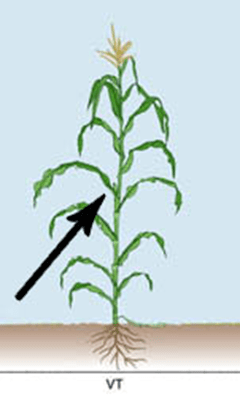Amy Shober, Professor and Extension Specialist, Nutrient Management and Environmental Quality, ashober@udel.edu; Jarrod Miller, Assistant Professor and Extension Specialist, Agronomy, jarrod@udel.edu
Corn is now nearing tassel in most parts of Delaware. As such, it might be worth the effort to collect mid-season tissue samples to help guide future nutrient management. While soil tests are used for fertilizer decisions, tissue analysis completed just before tassel can serve as a diagnostic tool to confirm suspected nutrient deficiencies and, in some cases, identify hidden hunger. Evaluating tissue test results along with results from a routine soil analysis will give a better idea of why a nutrient deficiency may have occurred.
Sufficiency ranges are available from several sources for many crops (Table 1). These ranges are useful when evaluating results of tissue analysis, but only if the tissue sample was taken at the same growth stage as was used to develop the sufficiency ranges. For corn, sufficiency ranges are available at various growth stages. For mid-season corn sampling, sufficiency ranges were developed for ear leaf samples at tasseling.
Table 1. Sufficiency ranges for corn ear leaf samples collected at tassel from the Southern Region*.
| Macronutrient | Range (%) | Micronutrient | Range (ppm) |
| N | 2.8-4.0 | Fe | 30-250 |
| P | 0.25-0.50 | Mn | 15-150 |
| K | 1.8-3.0 | Zn | 20-70 |
| Ca | 0.25-0.8 | Cu | 5-25 |
| Mg | 0.15-0.6 | B | 5-25 |
| S | 0.15-0.6 | Mo | 0.1-2.0 |

Figure 1. Collect the fully developed ear leaf at R1 for mid-season corn tissue analysis. Image courtesy of North Carolina Department of Agriculture and Consumer Services.
Remember, the results of tissue analysis are only as good as the sample they represent. Collect the whole ear leaf, which is the fully mature leaf located below the whorl (Figure 1) from a total of 15-25 plants between V12 and R1. Be sure to avoid dead, diseased, or damaged plant tissue or any tissue that appears to have been water or heat stressed. Collect samples from problem areas of the field separately from healthy plants and submit them for analysis as a troubleshooting sample.
University of Delaware and University of Maryland researchers recently completed a survey of ear leaf tissue samples from regional corn variety trials (2018-2020). This survey was funded by the Maryland Grain Producers and Utilization Board. Tissue concentrations of N, P, S, and Zn were often below the sufficiency ranges in Table 1 when grain yields were >250 bu/ac (N and P) or <175 bu/ac (S and Zn). We also noted deficient tissue Mg concentrations in about 50% of samples, regardless of yield; Mg deficiency was not predicted by soil testing. As such, we recommend caution when evaluating tissue Mg concentrations, as the sufficiency range in Table 1 may be too high.
Growers who are able to fertigate may be able to correct N or micronutrient deficiencies during this season. Otherwise, use the results of mid-season tissue analysis to guide nutrient management for future crops. Ultimately, we recommend that growers use tissue analysis results carefully, as plant tissue sufficiency ranges are not always based on local or current research. Results of tissue analysis are most valuable when done routinely (to monitor cropping conditions in a field over time) in conjunction with routine soil testing.
